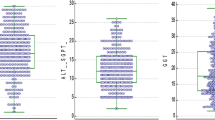Abstract
Reference intervals (RI) are the most common decision support tool used for interpretation of numerical laboratory reports. The quality of the RI can play as large a role in result interpretation as the quality of the result itself. As such there is hardly any study examining RI for liver specific biochemical parameters in Indian population especially north Indians having drastically different food habits as compared to rest of the India. So there is a need to establish the RI for north Indian population. Present study was conducted on 2,021 apparently healthy individuals of north Indian origin ranging in age from 15–60 years, were selected randomly using defined criteria. Lipemic, hemolysed, icteric and stored samples were also excluded adopting preanalytical criteria for rejection of sample. Non parametric methodology for determination of RI was adopted as most of the biochemical parameters included revealed non Gaussian distribution. Data were analyzed for middle 95 percentile (2.5th–97.5th percentile), median and 95 % confidence interval using SPSS software package version 10.0. The upper and the lower limit of RI (reported Vs observed) for bilirubin (0–1.2 Vs 0.30–1.30 mg/dL), serum glutamate oxaloacetate transferase (SGOT) (0–41 Vs 13–52.80 IU/L), serum glutamate pyruvate transferase (SGPT) (0–50 Vs 10–68 IU/L) showed wide variation as compared to reported standard RI however Gamma glutamyl transferase (GGT) (0–50 Vs 5.00–50.60 IU/L) remained within the reported standard RI. Further gender wise evaluation revealed higher cutoff in males (AST 14–55, ALT 11–70.35, GGT 6.76–51.09 in IU/L, bilirubin (0.40–1.34 mg/dL) as compared to females (SGOT 13–50.43, SGPT 9–63.43, GGT 3.92–48.70 in IU/L, Bilirubin 0.30–1.20 mg/dL) for both enzymatic and non enzymatic biochemical parameters. The variations may be attributed to dietary pattern smoking and alcoholism.









Similar content being viewed by others
References
Sasse Edward A, Doumas Basil T, D’Orazio Paul, Eckfeldt John H, Evans Susan A, Graham Gary A, et al. How to define and determine reference intervals in the clinical laboratory approved guideline second edition. NCCLS Document C28-A2. 2000; 20(13).
Solberg Helge Erik. The IFCC recommendation on estimation of reference intervals. The RefVal Program. Clin Chem Lab Med. 2004;42(7):710–4.
Horn Paul S, Pesce Amadeo J. Effect of ethnicity on reference intervals. Clin Chem. 2002;48(10):1802–4.
Aneke C, Nduka N, Maxwell-Owhochuku S. Comparison of some haematological indices of Africans and Caucasions resident in the Nigerian environment. Haematologia (Budapest). 1988;21(1):57–63.
Clinical and Laboratory Standards Institute. Defining, establishing and verifying reference intervals in the clinical laboratory; approved guideline, 3rd ed. CLSI document C28-A3. Wayne, PA: Clinical and Laboratory Standards Institute. 2008;28(30):61.
Doumas BT, Perry BW, Sasse EA, et al. Standardisation in bilirubin assays: evaluations of selected methods and stability of bilirubin solutions. Clin Chem. 1973;19:984–93.
Shaw LM, Stromme JH, London JL, Theodorsen L. IFCC methods for the determination of enzymes part 4. IFCC method for gamma glutamyl transferase [(gamma glutamyl)-peptide; amino acid gamma glutamyl transferase, EC 2.3.2.2.]. Clin Chem Acta. 1983;15F–338F.
Saris NE. Revised IFCC method for aspartate aminotransferase. Clin Chem. 1978;24:720–1.
Bergmeyer HU, Scheibe P, Wahlefeld AW. Optimization of methods for aspartate aminotransferase and alanine aminotransferase. Clin Chem. 1978;24:1.
Bowers GN, McComb RB. A continuous spectrophotometric method for measuring the activity of serum alkaline phosphatase. Clin Chem. 1966;12:70.
Kingsley GR. The direct biuret method for determination of serum proteins as applied to photoelectric and visual colorimetry. J Lab Clin Med. 1942;27:840–5.
Silverman LM, Christenson RH. Amino acids and proteins. In: Burtis CA, Ashwood ER, editors. Tietz textbook of clinical chemistry. 2nd ed. Philadelphia: W.B. Saunders; 1993. p. 696–8.
Doumas BT, Peters T Jr. Serum and urine albumin: a progress report on their measurement and clinical significance. Clin Chem Acta. 1997;258:3–20.
SPSS Chicago IL. SPSS Inc. 2003 http://www.spss.com. Accessed Sep 2008, AIIMS, New Delhi.
Sultana F, Anitha D, Venkatesh T. Estimation of reference values in liver function test in health plan individuals of urban south Indian population. Indian J Clin Biochem. 2004;19(2):72–9.
Ashavaid TF, Todur SP, Dherai AJ. Establishment of reference intervals in Indian population. Indian J Clin Biochem. 2005;20(2):110–8.
Yadav D, Mishra S, Gupta M, Sharma P. Reference intervals of certain liver specific biochemical analytes in Indian population. Indian J Clin Biochem. 2011;26(1):97–8.
Author information
Authors and Affiliations
Corresponding author
Rights and permissions
About this article
Cite this article
Yadav, D., Mishra, S., Gupta, M. et al. Establishment of Reference Interval for Liver Specific Biochemical Parameters in Apparently Healthy North Indian Population. Ind J Clin Biochem 28, 30–37 (2013). https://doi.org/10.1007/s12291-012-0281-0
Received:
Accepted:
Published:
Issue Date:
DOI: https://doi.org/10.1007/s12291-012-0281-0




